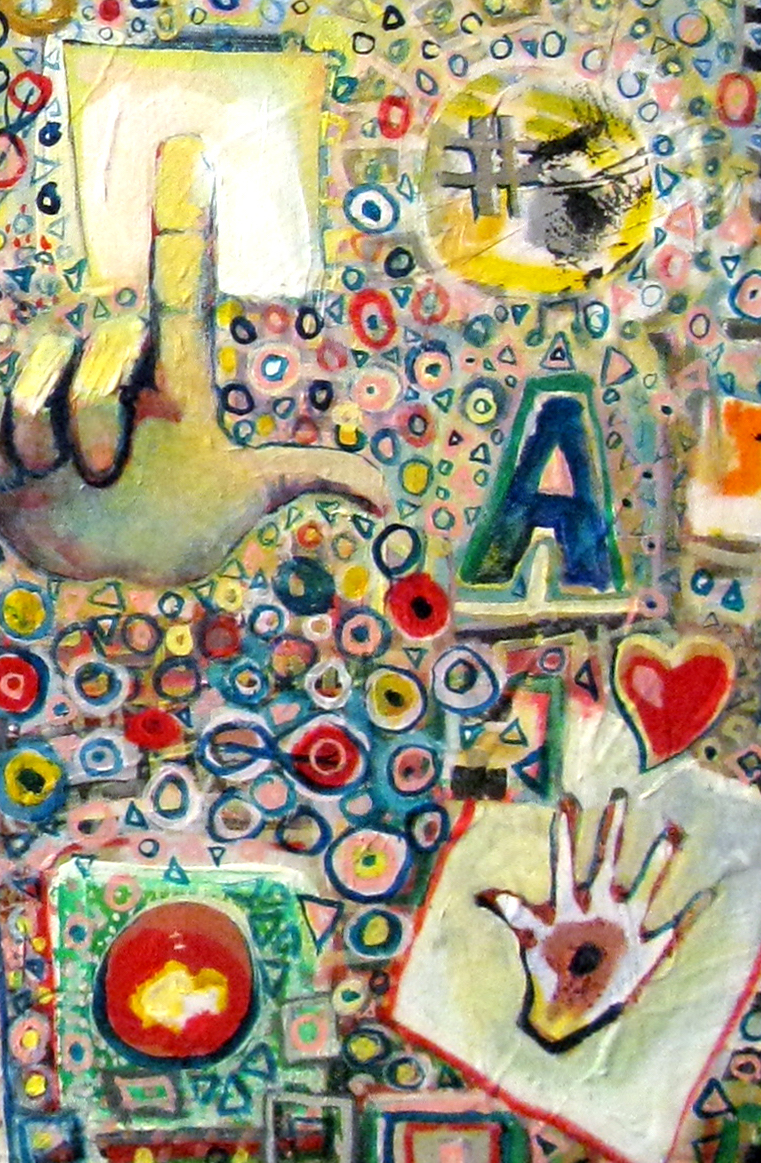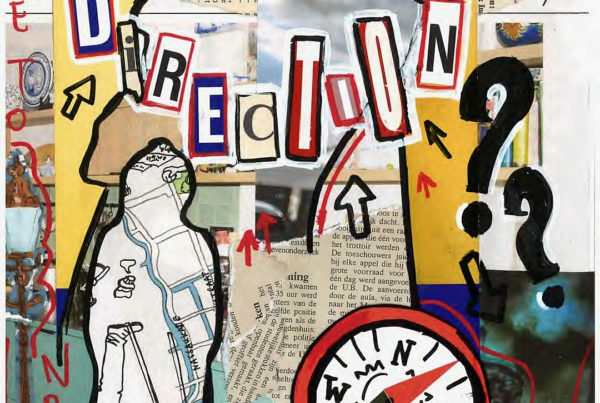
With the rise of the discussion on stigma regarding psychological disorders, a vary of parties have picked up on the battle against this. One of them is Beautiful Distress, an organisation fighting stigma through art. Is it helpful to talk about stigma for people with psychological distress, or might we have to look at this issue from a different perspective? And what role lies there for art in this debate?
With the rise of the discussion on stigma regarding psychological disorders, a vary of parties have picked up on the battle against this. One of them is Beautiful Distress, an organisation fighting stigma through art. Is it helpful to talk about stigma for people with psychological distress, or might we have to look at this issue from a different perspective? And what role lies there for art in this debate?

Painting: Scott Richard
Art is able to make you experience feelings that you never thought you would experience. That one painting that makes you feel so melancholic, or that photograph that provokes a strange feeling of sadness. This is a unique power art has: it can show us feelings of fear, distress or loneliness for which we might otherwise had closed our eyes. To art we don’t have to relate ourselves as we do to another human being. We might feel uncomfortable perceiving another person’s distress, and often won’t be able to think of a comforting reaction in response to these feelings. This is why, when art provokes these feelings within us, it is a whole different experience: we can explore these feelings without immediately having to react to them. Art is therefore often used in the debate regarding psychological disorders, to express feelings of distress and to battle the stigma surrounding these disorders. It might however not be sufficient to use art as a means to battle this stigma.
The uncomfortable feelings as mentioned above are some- thing a lot of psychiatric patients these days are still met with. We’re scared of the man in the streets we hear talking to people we can’t see, but are also not sure how to approach a loved one when they might be feeling so blue they distance themselves from us. In the public debate, the word stigma is used to coin this negative approach of psychiatric patients:
“‘Stigma (n.) [..] a mark of disgrace associated with a particular circumstance, quality, or person..’”
– Online Etymology Dictionary (2019)
Stigma leads to prejudices and, in a worst case scenario, to the exclusion of psychiatric patients from our society. Throughout the years, the topic of stigma has gained more attention in the public debate. Governments are launching anti-stigma campaigns, and social media is full of celebrities sharing their stories of mental illness in the hopes of reducing the stigma on these psychological disorders. With the rise of the discussion on stigma, organizations trying to battle this stigma gained more attention as well. One of these organizations is Beautiful Distress, founded to deploy art as a means to make the suffering of psychiatric patients visible. Their goal is to create compassion and understanding for those suffering from psychological distress and the people close to them. Through artists and the art created by them, Beautiful Distress intends to spark conversations about mental illness. Art appeals to your feelings, emotions and your mind as well. It can make you see things from a different perspective, which is exactly what is needed when talking about mental illness and psychiatric patients. Beautiful Distress is on a mission to get rid of stigma: by making the stigma explicit, and mentioning it over and over again, it can be fought and eventually eradicated.
Beautiful Distress and het Vijfde Seizoen (‘the Fifth Season’), another organization battling stigma through art, combined their forces and organized a manifestation on the subject of (the stigma on) psychiatric disorders. This manifestation included a symposium and an exhibition, which were captured in a book called Beautiful Distress (2019).
The main problem with this battle against stigma is that, by calling out this stigma, the underlying suffering won’t disappear. Talking about one’s major depressive disorder does not do justice to the excruciating feelings of helplessness someone might be experiencing. Even though it is now more widely accepted to mention that you suffer from depression, or an anxiety disorder, we still won’t say out loud that we are lonely, scared or extremely sad, for maybe no demonstrable reason at all. Talking in terms of DSM-5 language won’t help us battle the stigma that makes it so hard to talk about feelings of exclusion or loneliness.
Another issue with stigma is that we might be looking at it from the wrong perspective, as explained by Nathan Filer in his book The Heartland: Finding and Losing Schizophrenia (2019):
‘Stigma refers to a person’s feelings of shame, disgrace or inadequacy due to their circumstances. Getting sacked from work could certainly lead to such feelings. So too could being shunned or ridiculed by those around us. But in these scenarios stigma is the result, not the cause. The psychologists Anne Cooke and Dave Harper argue that stigma individualizes what may in fact be issues of prejudice and discrimination.’
“Talking about stigma might dismiss the bigger issues at stake, such as poverty”
Talking about stigma might thus dismiss what seem to be the bigger issues at stake, such as poverty, social exclusion and prejudice. Filer goes on to quote psychologist and author Lucy Johnstone. She describes how governments have all leapt onto the anti-stigma campaignstrain, without actually tackling these issues like poverty and social exclusion. She explains that not much is done about people being targeted by the benefits office, or the huge increase in inequality. This is the stuff that could drive people crazy. Johnstone argues that saying we’ve got schizophrenia as a diagnosis does not mean we’re making any progress. Talking about anti-stigma is politically motivated, meant to make the government look well-meaning.
Beautiful Distress is, of course, not a governmental organization, but I still think it is very important to consider what we’re actually talking about, when we talk about stigma. Is talking about stigma truly going to change the way psychiatric patients are viewed by most people? An open discourse on these topics is definitely something that is badly needed, but all the while it would be valuable to look at the causes underlying these psychiatric disorders, and pinpoint the issues at hand, such as discrimination.
Although talking about stigma might not solve the problems underlying it, Beautiful Distress is still a great example of how art can bridge the gap between the suffering of psychiatric patients and the public debate. It gives a voice to those suffering in silence, and uses art to express these feelings. It does what art does so well, as eloquently spoken by Dirk de Wachter, a Belgian psychiatrist and author, in his book De Wereld van de Wachter (2016). In art, the vulnerability of being the minority takes place, which is often essential as an inspiration. The hidden wounds and scars are being turned around, into a power that speaks to the fragility of the other. The artwork forms the exceedance, the connection, of the mutual strangeness.
I would argue that talking about stigma, but not the underlying causes, might not be the most beneficial thing to do, but paying attention to psychological disorders through the use of art does seem to be. Art, in whichever form, speaks to us in a way that anti-stigma campaigns or the likes are not able to do. Through art certain feelings can be expressed, which might otherwise have been left unsaid. Combining the forces of artists, psychiatric patients and mental health professionals is a powerful tool to shed light on the misunderstandings and prejudices regarding mental health issues. <<
References
– [Image] Retrieved at October 25, 2019 from https://www.flickr. com/photos/gazeronly/44276385382/.
– Beautiful Distress (2018). Beautiful Distress. Amsterdam, the Netherlands: Beautiful Distress.
– De Wachter, D. (2016). De wereld van de wachter. Leuven, Bel- gium, Lannoo Meulenhoff-Belgium.
– Filer, N. (2019). The Heartland: finding and losing schizophrenia. London, United Kingdom: Faber & Faber.
Art is able to make you experience feelings that you never thought you would experience. That one painting that makes you feel so melancholic, or that photograph that provokes a strange feeling of sadness. This is a unique power art has: it can show us feelings of fear, distress or loneliness for which we might otherwise had closed our eyes. To art we don’t have to relate ourselves as we do to another human being. We might feel uncomfortable perceiving another person’s distress, and often won’t be able to think of a comforting reaction in response to these feelings. This is why, when art provokes these feelings within us, it is a whole different experience: we can explore these feelings without immediately having to react to them. Art is therefore often used in the debate regarding psychological disorders, to express feelings of distress and to battle the stigma surrounding these disorders. It might however not be sufficient to use art as a means to battle this stigma.
The uncomfortable feelings as mentioned above are some- thing a lot of psychiatric patients these days are still met with. We’re scared of the man in the streets we hear talking to people we can’t see, but are also not sure how to approach a loved one when they might be feeling so blue they distance themselves from us. In the public debate, the word stigma is used to coin this negative approach of psychiatric patients:
“‘Stigma (n.) [..] a mark of disgrace associated with a particular circumstance, quality, or person..’”
– Online Etymology Dictionary (2019)
Stigma leads to prejudices and, in a worst case scenario, to the exclusion of psychiatric patients from our society. Throughout the years, the topic of stigma has gained more attention in the public debate. Governments are launching anti-stigma campaigns, and social media is full of celebrities sharing their stories of mental illness in the hopes of reducing the stigma on these psychological disorders. With the rise of the discussion on stigma, organizations trying to battle this stigma gained more attention as well. One of these organizations is Beautiful Distress, founded to deploy art as a means to make the suffering of psychiatric patients visible. Their goal is to create compassion and understanding for those suffering from psychological distress and the people close to them. Through artists and the art created by them, Beautiful Distress intends to spark conversations about mental illness. Art appeals to your feelings, emotions and your mind as well. It can make you see things from a different perspective, which is exactly what is needed when talking about mental illness and psychiatric patients. Beautiful Distress is on a mission to get rid of stigma: by making the stigma explicit, and mentioning it over and over again, it can be fought and eventually eradicated.
Beautiful Distress and het Vijfde Seizoen (‘the Fifth Season’), another organization battling stigma through art, combined their forces and organized a manifestation on the subject of (the stigma on) psychiatric disorders. This manifestation included a symposium and an exhibition, which were captured in a book called Beautiful Distress (2019).
The main problem with this battle against stigma is that, by calling out this stigma, the underlying suffering won’t disappear. Talking about one’s major depressive disorder does not do justice to the excruciating feelings of helplessness someone might be experiencing. Even though it is now more widely accepted to mention that you suffer from depression, or an anxiety disorder, we still won’t say out loud that we are lonely, scared or extremely sad, for maybe no demonstrable reason at all. Talking in terms of DSM-5 language won’t help us battle the stigma that makes it so hard to talk about feelings of exclusion or loneliness.
Another issue with stigma is that we might be looking at it from the wrong perspective, as explained by Nathan Filer in his book The Heartland: Finding and Losing Schizophrenia (2019):
‘Stigma refers to a person’s feelings of shame, disgrace or inadequacy due to their circumstances. Getting sacked from work could certainly lead to such feelings. So too could being shunned or ridiculed by those around us. But in these scenarios stigma is the result, not the cause. The psychologists Anne Cooke and Dave Harper argue that stigma individualizes what may in fact be issues of prejudice and discrimination.’
“Talking about stigma might dismiss the bigger issues at stake, such as poverty”
Talking about stigma might thus dismiss what seem to be the bigger issues at stake, such as poverty, social exclusion and prejudice. Filer goes on to quote psychologist and author Lucy Johnstone. She describes how governments have all leapt onto the anti-stigma campaignstrain, without actually tackling these issues like poverty and social exclusion. She explains that not much is done about people being targeted by the benefits office, or the huge increase in inequality. This is the stuff that could drive people crazy. Johnstone argues that saying we’ve got schizophrenia as a diagnosis does not mean we’re making any progress. Talking about anti-stigma is politically motivated, meant to make the government look well-meaning.
Beautiful Distress is, of course, not a governmental organization, but I still think it is very important to consider what we’re actually talking about, when we talk about stigma. Is talking about stigma truly going to change the way psychiatric patients are viewed by most people? An open discourse on these topics is definitely something that is badly needed, but all the while it would be valuable to look at the causes underlying these psychiatric disorders, and pinpoint the issues at hand, such as discrimination.
Although talking about stigma might not solve the problems underlying it, Beautiful Distress is still a great example of how art can bridge the gap between the suffering of psychiatric patients and the public debate. It gives a voice to those suffering in silence, and uses art to express these feelings. It does what art does so well, as eloquently spoken by Dirk de Wachter, a Belgian psychiatrist and author, in his book De Wereld van de Wachter (2016). In art, the vulnerability of being the minority takes place, which is often essential as an inspiration. The hidden wounds and scars are being turned around, into a power that speaks to the fragility of the other. The artwork forms the exceedance, the connection, of the mutual strangeness.
I would argue that talking about stigma, but not the underly- ing causes, might not be the most beneficial thing to do, but paying attention to psychological disorders through the use of art does seem to be. Art, in whichever form, speaks to us in a way that anti-stigma campaigns or the likes are not able to do. Through art certain feelings can be expressed, which might otherwise have been left unsaid. Combining the forces of artists, psychiatric patients and mental health professionals is a powerful tool to shed light on the misunderstandings and prejudices regarding mental health issues. <<



